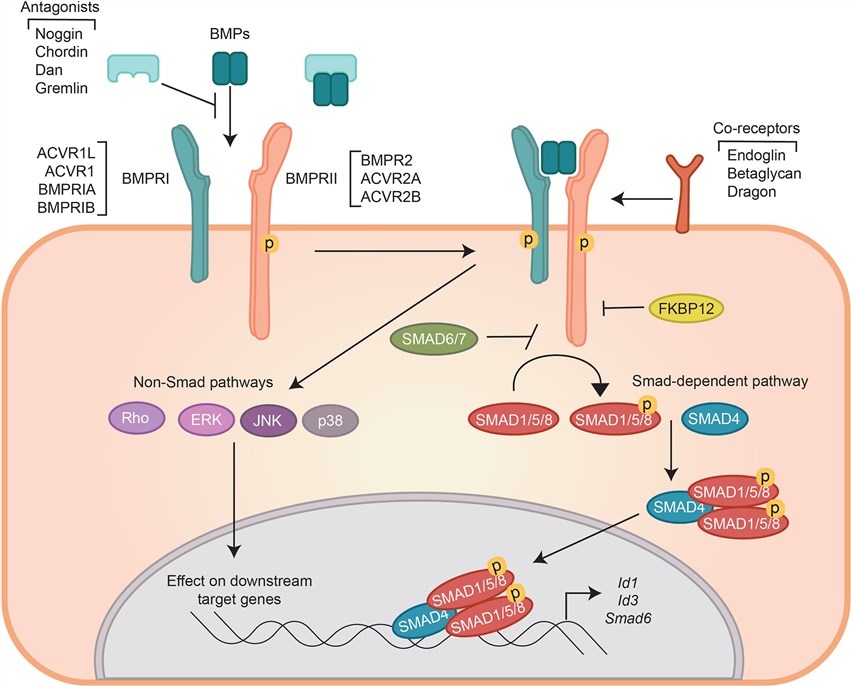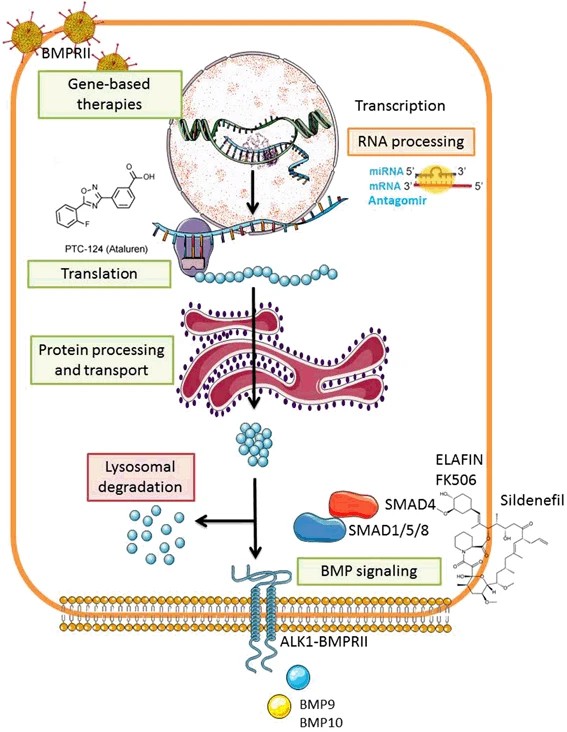BMP Receptor
Available Resources for BMP Receptor Research
Creative BioMart offers a wide variety of products related to BMP receptors, including recombinant proteins, protein pre-coupled magnetic beads, and cell and tissue lysates. Our customized services are available to meet your specific needs and ensure you get the right product.
In addition to our products and services, we provide a wealth of information on BMP receptors, including pathways, protein function, interacting proteins, related articles, research areas, and other relevant topics. These resources are essential for researchers seeking to deepen their understanding of BMP receptors and their involvement in physiological processes.
Our Featured Products
| Cat.# | Product name | Species | Source (Host) | Tag |
|---|---|---|---|---|
| BMPR1A-771H | Recombinant Human BMPR1A, Fc-His tagged | Human | Human Cell | Fc/His |
| BMPR1A-2876H | Recombinant Human BMPR1A protein, His-tagged | Human | E.coli | His |
| Bmpr1a-247M | Active Recombinant Mouse Bmpr1a protein, His&hFc-tagged | Mouse | HEK293 | His&hFc |
| Bmpr1a-24M | Active Recombinant Mouse Bmpr1a protein(Met1-Arg152), His-tagged | Mouse | HEK293 | C-His |
| BMPR2-134H | Recombinant Human BMPR2, His-tagged | Human | HEK293 | His |
| BMPR2-133H | Active Recombinant Human BMPR2 protein, His&hFc-tagged | Human | HEK293 | His&hFc |
| BMPR2-10258H | Recombinant Human BMPR2, His-tagged | Human | E.coli | His |
About BMP Receptor
The Bone Morphogenetic Protein (BMP) receptors are transmembrane proteins that play a crucial role in mediating BMP signaling. They consist of two main types: type I receptors and type II receptors. Here's an overview of their structure and function:
Type I Receptors
Also known as BMP receptor type IA, IB, IC, ID, and IE (ALK1, ALK3, ALK4, ALK5, ALK6), type I receptors are serine/threonine kinases.
- Structure: Type I receptors have an extracellular ligand-binding domain, a single-pass transmembrane domain, and an intracellular kinase domain.
- Function: Type I receptors initiate the intracellular signaling cascade upon ligand binding. They are responsible for phosphorylating downstream signaling molecules called SMAD proteins.
- Ligand Specificity: Each type I receptor has distinct ligand-binding specificity and can bind to specific BMP ligands.
Type II Receptors
The main type II receptor involved in BMP signaling is BMP receptor type II (BMPR-II).
- Structure: Type II receptors also have an extracellular ligand-binding domain, a single-pass transmembrane domain, and an intracellular kinase domain.
- Function: Type II receptors, primarily BMPR-II, bind BMP ligands and form a complex with type I receptors upon ligand binding. They initiate the signaling cascade by phosphorylating and activating the type I receptors.
- Ligand Specificity: BMPR-II has broad ligand-binding specificity and can interact with multiple BMP ligands.
 Fig.1 BMPR signaling. (Gomez-Puerto M C, et al., 2019)
Fig.1 BMPR signaling. (Gomez-Puerto M C, et al., 2019)
BMPs signal via complexes of type I (BMPRIs) and type II (BMPRIIs) transmembrane kinase receptors. The type II receptor, a constitutively active kinase (shown in the figure as phosphorylated), phosphorylates (specified as P) and activates the type I receptor, upon which intracellular canonical signaling is initiated by phosphorylation of receptor-regulated R-SMAD1, 5, and 8. Activated R-SMADs partner with SMAD4 to transcriptionally regulate expression of specific target genes. BMPR activation can also induce non-SMAD signaling, e.g. by activating p38 and JNK MAP kinases and small GTPases such as Rho and Rac. Each step in the pathway is fine-tuned by positive and negative regulation. For example, ligand bioavailability for the receptor can be regulated by ligand-binding proteins, also called antagonists, which sequester the ligand from interacting with receptors. BMP type III receptors or accessory co-receptors can enhance BMP signaling by presenting ligands to type I and type II receptors.
Role of BMP Receptor in Cellular Signaling Pathways
BMP (Bone Morphogenetic Protein) receptors play a vital role in cellular signaling pathways, particularly in the BMP signaling pathway. They are key components in transmitting the BMP signal from the extracellular environment to the intracellular space, ultimately leading to the activation of downstream signaling events and regulation of gene expression. Here's an overview of the role of BMP receptors in cellular signaling pathways:
- Ligand Binding and Receptor Complex Formation
- BMP ligands, such as BMP-2, BMP-4, BMP-7, bind to BMP receptors on the cell surface.
- Binding of ligands induces the formation of a receptor complex, typically composed of one type II receptor (e.g., BMPR-II) and two type I receptors (e.g., ALK1, ALK3, ALK6).
- The ligand-induced receptor complex brings the type II and type I receptors into close proximity, allowing for their mutual transphosphorylation and activation.
- Activation of Intracellular Signaling Pathways
- Upon activation, type II receptors phosphorylate specific serine and threonine residues in the glycine-serine (GS) region of the type I receptors.
- Phosphorylation of type I receptors enables their activation and subsequent phosphorylation of downstream signaling molecules known as receptor-regulated SMADs (R-SMADs).
- In the BMP pathway, the activated type I receptors phosphorylate SMAD1, SMAD5, or SMAD8, which are the R-SMADs involved in BMP signaling.
- SMAD-Mediated Transcriptional Regulation
- Phosphorylated R-SMADs form complexes with a common SMAD (Co-SMAD), typically SMAD4.
- The R-SMAD/Co-SMAD complexes translocate into the nucleus, where they act as transcription factors.
- In the nucleus, the R-SMAD/Co-SMAD complexes bind to specific DNA sequences, known as SMAD-binding elements (SBEs), within the promoters of target genes.
- This binding leads to the regulation of gene transcription, either promoting or inhibiting the expression of target genes, depending on the context.
- Crosstalk with Other Signaling Pathways
- BMP signaling pathways often cross-talk with other signaling pathways, such as Wnt, Notch, and TGF-β pathways.
- These interactions can occur at various levels, including ligand-receptor interactions, intracellular signaling components, and downstream transcriptional regulation.
- The cross-talk between BMP signaling and other pathways allows for the integration of multiple signaling inputs and the modulation of cellular responses.
- Negative Regulation
- The BMP signaling pathway is tightly regulated to maintain proper cellular responses and prevent excessive signaling.
- Negative regulators, such as inhibitory SMADs (SMAD6 and SMAD7), are involved in feedback loops and inhibit BMP signaling by interfering with receptor activation or downstream signaling events.
By initiating intracellular signaling cascades, BMP receptors play a critical role in mediating BMP signaling and regulating gene expression. These signaling pathways are essential for various cellular processes, including embryonic development, tissue homeostasis, cell differentiation, and tissue regeneration. Understanding the role of BMP receptors in cellular signaling provides insights into their involvement in normal physiological processes and their potential as therapeutic targets in various diseases and disorders.
 Fig.2 Rescuing the BMPRII signaling pathway in pulmonary arterial hypertension. (Orriols M, et al., 2017)
Fig.2 Rescuing the BMPRII signaling pathway in pulmonary arterial hypertension. (Orriols M, et al., 2017)
If you have any questions, requirements, or cooperation intentions, please feel free to contact us. We very much look forward to working with you and helping you achieve research and commercial success.
References:
- Gomez-Puerto M C, Iyengar P V, García de Vinuesa A, et al. Bone morphogenetic protein receptor signal transduction in human disease[J]. The journal of pathology, 2019, 247(1): 9-20.
- Orriols M, Gomez-Puerto M C, Ten Dijke P. BMP type II receptor as a therapeutic target in pulmonary arterial hypertension[J]. Cellular and Molecular Life Sciences, 2017, 74: 2979-2995.


